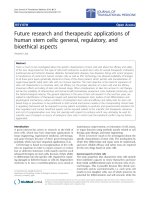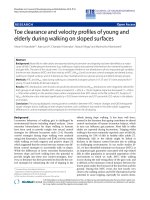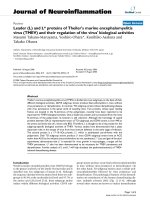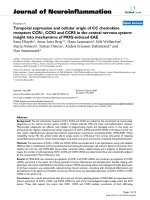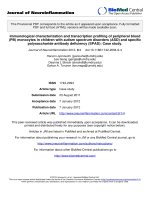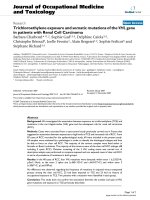báo cáo hóa học:" High survival and treatment success sustained after two and three years of first-line ART for children in Cambodia" potx
Bạn đang xem bản rút gọn của tài liệu. Xem và tải ngay bản đầy đủ của tài liệu tại đây (702.9 KB, 10 trang )
RESEARC H Open Access
High survival and treatment success sustained
after two and three years of first-line ART for
children in Cambodia
Petros Isaakidis
1*
, Marie-Eve Raguenaud
1
, Vantha Te
2
, Chhraing S Tray
3
, Kazumi Akao
3
, Varun Kumar
3
,
Sopheak Ngin
4
, Eric Nerrienet
4
, Rony Zachariah
5
Abstract
Background: Long-term outcomes of antiretroviral therapy (ART) in children remain poorly documented in
resource-limited settings. The objective of this study was to assess two-and three-year survival, CD4 evolution and
virological response among children on ART in a programmatic setting in Cambodia.
Methods: Children treated with first-line ART for at least 24 months were assessed with viral load testing and
genotyping. We used Kaplan-Meier analysis for survival and Cox regression to identify risk factors associated with
treatment failure.
Results: Of 1168 registered HIV-positive children, 670 (57%) started ART between January 2003 and December
2007. Survival probability was 0.93 (95% CI: 0.91-0.95) and 0.91 (95% CI: 0.88-0.93) at 24 and 36 months after ART
initiation, respectively. Median CD4 gain for children aged over five years was 704 cells/mm
3
at 24 months and 737
at 36 months. Median CD4 percentage gain for children under five years old was 15.2% at 24 months and 15% at
36 months. One hundred and thirty children completed at least 24 months of ART, and 138 completed 36 mon ths:
128 out of 268 (48%) were female. Median age at ART initiation was six years.
Overall, 22 children had viral loads of >1000 copies/ml (success ratio = 86% on intention-to-treat-analysis) and 21
of 21 presented mutations conferring resistance mostly to lamivudine and non-nucleoside reverse transcriptase
inhibitors. Risk factors for failure after 24 and 36 months were CD4 counts below the threshold for severe immuno-
supression at those months respectively. Only two out of 22 children with viral loads of >1000 copies/ml met the
World Health Organization immunological criteria for failure (sensitivity = 0.1).
Conclusions: Good survival, immunological restoration and viral suppression can be sustained after two to three
years of ART among children in resource-constrained settings. Increased access to routine virological measurements
is needed for timely diagnosis of treatment failure.
Background
Pediatric HIV/AIDS care programmes in resource-lim-
ited settings have been reporting good antiretroviral
treatment (ART) outcomes, comparable to those in
high-income countries [1-15]. However, most of these
reports describe early experiences and treatment out-
comes. Reports of medium- and long-term clinical and
immunological outcomes among children on ART in
resource-poor settings are still scarce and, when avail-
able, are usually limited to relatively small cohorts.
Similarly, there are few studies of medium- a nd long-
term virological outcomes and antiretroviral drug resis-
tance among children receiving ART in programmatic
settings where viral load (VL) measurements and geno-
typing are seldom available [1,2].
With an estimated HIV prevalence of 0.9% in the
adult populat ion (15-49 years) by the end of 2008 (esti-
mated at 2.2% in 1997) and an estimated 4400 children
living with HIV, Cambodia is one of the worst-affected
countries in south-east Asia [16,17]. Médecins Sans
Frontières (MSF), the Cambodian National Center for
Control of HIV/AIDS, Dermatology and STD
* Correspondence:
1
Médecins Sans Frontières, Phnom Penh, Cambodia
Isaakidis et al. Journal of the International AIDS Society 2010, 13:11
/>© 2010 Isaakidis et al; licensee BioMed Central Ltd. This is an Open Acce ss article di stributed under t he terms of the Creative Co mmons
Attribution License ( which permits unrestricted use, distribution, and reproduction in
any medium, provided the original work is prop erly cited.
(NCHADS), and Angkor Hospital for Children in Siem
Reap have been treating HIV-posi tive children in Siem
Reap and Takeo provinces since February 2003 and
2004, respectively.
More than 1100 HIV-positive children had been
enrolled and more than 650 had been started on ART
by the end of 2007. These two large-scale pediatric pro-
gram mes represented 25% of the nationa l pediatric HIV
cohort and more than 25% of the total children on ART
in the country. We previously described excellent out-
comes, with more than 80% virological success in this
pediatric cohort, after 12 months of treatment [4,5].
The aim of the current study was to assess whether
the effectiveness of ART was sustained after 24 to 36
mont hs of follow up. We report on survival, CD4 count
evolution, virological response, and antiretroviral drug
resistance patt erns among HIV-positive children receiv-
ing first-line ART in a programmatic setting in
Cambodia.
Methods
Setting
In collaboration with NCHADS, MSF supported pedia-
tric HIV programmes in two hospitals in Cambodia: the
Angkor Hospital for Children, a char ity hospital located
in Siem Reap province (population 700,000), and Don-
keo Referral Hospital, a public health facility in Takeo
Province (population 800,000). Since 2003 and 2004,
respectively, ART was offered free of charge to HIV-
positive children, confirmed with serology or reverse
transcriptase polymerase chain reaction (RT-PCR) for
children under 18 months, and CD4 count below 20%
for children younger than five years of age, or below
200 cells/mm
3
for children older than five years.
Treatment and follow up
The standard first-line regimen was stavudine , lamivu-
dine and nevirapine, as recommended by the World
Health Organization (WHO) [18]. Zidovudine and efa-
virenz were used as alternatives in case of intolerance or
interaction with other drugs.
Preparation for ART initiation included a minimum of
three counselling sessions for the caregiver and patient,
depending on the age of the child. Follow-up visits were
monthly throughout the study period.
CD4 count and/or CD4 percentage were monitored
every six months. Viral load moni toring and genotyping
were not routinely performed, but only used to confirm
clinical and/or immunological failure by treating physi-
cians. Adherence support was provided to caregivers
and children at each visit by specially trained counsel-
lors through individual and age-specific support group
sessions. An active tracing system for patients who failed
to attend a clinic appointment was set up, and included
home visits, additional counselling sessions and psycho-
social support.
Study population
All HIV-positive children aged 15 years or younger who
had registered in the two pediatric HIV/AIDS pro-
grammes and who had comp leted at least 24 months of
first-line ART by December 2007 were eligible for this
study. All children ever started on ART, regardless of
time on treatment, were included in the overall survival
analysis of the total cohort and the cohort CD4 evolu-
tion analysis.
Cross-sectional viral load measurements and genotyping
Between December 2007 and October 2008, eligible
patients had a VL measurement done together with their
routine CD4 test. CD4 measurement s were performed at
a Cambodian Ministry of Health Reference Laboratory
(Kampong Cham Referral Hospital) and at the National
Institute of Public Health Laboratory in Phnom Penh.
HIV-1 RNA VLs were measured at the Pasteur Institute
of Cambodia by real-time RT-PCR, using the ANRS G2
LTR-based real-time RT-PCR assay (Generic HIV-1 viral
load, Biocentric, Bandol, France) [19]. For patients with
VL >1000 HIV-1 RNA copies/ml o f plasma, a genotypic
resistance test was done. HIV-RNA was extracted
(QIAampViral RNA mini k it, Qiagen, Germany). RT-
PCR-amplified fragments in the reverse transcriptase
gene of HIV-1 were sent to Macrogen Company (Macro-
gen Inc. Seoul, Republic of Korea) for sequencing.
Chromatograms, sent back electronically to Pasteur
Institute of Cambodia, were verified, analyzed and inter-
preted. Clustal X 1.81 software was used for alignment
with subtype reference sequences set from the Los Ala-
mos HIV Sequence Database ( />content/sequence/HIV/refer.html as wel l as for phyloge-
netic analysis using a nucleotide-distance matrix and the
bootstrap neighbor-joining method. The resi stant muta-
tions were defined according to the WHO HIV Drug
Resistance Database />WHOResistanceList.html and the drug susceptibility was
predicted according to the French National Agency for
AIDS Research (ANRS) algorithm fren-
chresistance.org/.
In addition, for each study participant, a short ques-
tionnaire was completed by a counsellor or doctor on
the same day that an informed consent was obtained.
Questions were aimed at identifying factors potentially
associated with poor adherence, such as: age of care-
giver; education and literacy level of caregiver; distance
of house to the clinic; size of family; and status of par-
ents (alive/dead).
Isaakidis et al. Journal of the International AIDS Society 2010, 13:11
/>Page 2 of 10
Statistical analysis
Medical follow-up data were routinely collected at each
consultation and entered prospectively into FUCHIA
©
monitoring software (Follow up and Care of HIV Infec-
tion and AIDS, EPICENTRE, Paris).
The Kaplan-Meier method was used to estimate survi-
val for all children on an intention-to-treat basis.
Patients were censored on the date of their last visit, or
date of transfer, or date of death, before 31 December
2007 . CD4 gains were calculated on a six-monthly basis
after ART initiation and weight-for-age z-score increases
were recorded annually. Success ratio of the entire ART
cohort was calculated on an intention-to-treat basis.
Treatment failures were defined as patients with VLs
of >1000 copies/ml (before and after 24 months of
ART), and patients who died, were lost to follow up, or
were not assessed. Patients who did not return within
three months of their scheduled follow-up visit were
considere d lost to follow up. Rate ratios were calculated
to identify factors associated with virological failure after
24 months of ART. The Cox proportional hazards
model was fitted to identify determinants of virological
failure. Statistical analyses were performed using Stata
8.2 software (Stata Corporation, College Station, Texas,
USA).
Ethics
The study protocol was approved by th e National Ethics
Committee for Health Research of Cambodia, the Ethics
Review Board of Médecins Sans Frontières, and the
Institutional Review Board of Angkor Hospital for Chil-
dren, Cambodia. All participants’ caregivers gave their
written informed consent.
Results
Outcomes and survival of all children on ART
A tot al of 1168 HIV-positive children were registered in
the two HIV clinics between March 2002 and December
2007, of whom 670 (57%) started ART between January
2003 an d December 2007. Among the 670 children who
started ART, 37 (5.5%) had died, 13 (2.0%) were lost to
follow up and 47 (7.0%) were transferred out by the end
of December 2007. Median time of follow up since ART
initiation for all children ever started ART was 24
months (IQR: 12-34). Estimates of survival after admis-
sion were 0.93 at 24 months (95% CI: 0.91-0.95) and
0.91 at 36 months (95% CI: 0.88-0.93) when death and
loss-to-follow-up events were combined (Figure 1).
Characteristics of children on ART ≥ 24 months at time of
ART initiation
Among the 670 children who had started ART, 285
were on first-line ART for at least 24 months by end of
December 2007 and were thus eligible for the study
(Figure 2). Among these, 268 were assessed with viral
load measurement and completed the study question-
naire after 1 December 2007. Six patients were trans-
ferred out before study inclusion could take place, two
declined to take part, and nine answered the question-
naire but did not stay for blood sampling. One hundred
and thirty-eight of the 268 (51.5%) children were on
ART for at least 36 months at the time of the assess-
ment. Median follow-up time from ART initiation until
end of observation time or date of failure was 36.2
months (IQR: 30.7-40.7).
One hundred and twenty-ei ght out of 268 (48%) were
female and the median age was six years (IQR: 4-8).
Only one child was aged less than 18 months at A RT
initiation. A high proportion of children were already at
an advanced stage of HIV disease when starting treat-
ment: 103 (38%) and 53 (20%) were at CDC stages B
and C, r espectively. Median CD4 count was 190 cells/
mm
3
for children older than five years (IQR: 54-342),
and median CD4 cell percentage for children under five
years was 11.0% (IQR: 6.0-15.8) (Table 1). Regarding
nutritional status at treatment initiation, the median
weight-for-age z-score was -2.7 (IQR: -3.2 to -2.1).
Clinical and immunological outcomes of patients on ART
≥ 24 months
Median CD4 gain from baseline value for children over
five years was found to be 704 cells/mm
3
(IQR: 469-
1034) at 24 months (n = 158) and 737 (IQR: 546-924) at
36 mont hs (n = 115) (Figure 2). Median CD4 per centage
gain from baseline value for children under five years was
found to be 15.2% (IQR: 12.6-21.6) at 24 months (n = 96)
and 15.0% (IQR: 13.1-16.0) at 36 months (n = 12) (Figure
3). In the early years of the programmes, limited access
to CD4 measurements resulted in some missing CD4 and
CD4 percentage data in this cohort of children. The
weight-for-age z-score median gain on ART was 1.88
(IQR: 1.41-2.43) during the second year, and 2.96 (IQR:
2.26-3.97) during the third year.
Cross-sectional virological survey of patients more than
24 months on ART
Two hundred and forty out of 268 children assessed
with VL had an undetectable VL ( ≤ 250 copies/ml), six
had a VL between 250 and 1000 copies/ml and 22 had a
VL above 1000 copies/ml, of whom 15 were over 10,000
copies/ml. Among 130 and 138 patients on ART for at
least 24 and 36 months, 112 (86.1%) and 134 (97.1%)
patients, respectively, had undetectable VL. The overall
treatment success ratio for the cohort on ART for at
least 24 months was 86% in an intention-to-trea t analy-
sis. Among 22 children with a VL above 1000 copies
after 24 month s of ART, onl y two were in immunologi-
cal failure according to the WHO criteria [18].
Isaakidis et al. Journal of the International AIDS Society 2010, 13:11
/>Page 3 of 10
Reverse transcriptase HIV-1 drug resistance patterns
HIV-1 reverse transcriptase genotyping was pe rformed
for 21 patients with VLs above 1000 copies/ml after 24
months of ART. Genetic analysis revealed that all these
children were infected with CRF01_AE viruses. Accord-
ing to the WHO HIV epidemiological survey for scoring
resistance-associated mutations list, the most frequent
mutations were M184I (n = 18), Y181C (n = 15),
K103N (n = 7) and G190A (n = 6) (Figure 4). All these
children were found to be resistant to nevirapine/efavir-
enz. Seventeen of 21 were resistant to lamivudi ne/emtri-
citabine and three others possibly resistant to
lamivudine/emtricitabine. Six children of 21 were resis-
tant to stavudine and/or zidovudine. Two were resistant
to didanosine and three others possibly resistant to this
nucleoside reverse transcriptase inhibitor, three to aba-
cavir and three possibly resistant to abacavir. Finally,
four were resistant and one possibly resistant to
tenofovir.
Six out of 22 children had developed a profile of
extensive resistance, explained by the presence of the
K65R mutation in four children and Q151 M in two
children.
1000 copies/ml",1,0,1,0,0pc,0pc,0pc,0pc>Factors
associated with a VL >1000 copies/ml
Only CD4 counts and CD4 percentages below the
threshold for severe immunosupression [18] at 24 and
36 months predicted treat ment failure at those times.
Children coming late to their clinic appointments were
not at higher risk for virological failure. Orphan status
and caregiver characteristics, including literacy, age and
socio-economic status, were similarly not associated
with treatment failure after 24 months of ART.
Discussion
This study, with a large cohort of children on ART,
showed that first-line treatment remained effective in
Figure 1 Survival of children who started ART, 2002-2008, Takeo and Siem Reap, Cambodia
Isaakidis et al. Journal of the International AIDS Society 2010, 13:11
/>Page 4 of 10
the medium term. Ninety-three percent of children in
our HIV-programmes were alive and in care at the end
of the observation period. Rapid and sustained immune
restoration over time, a high virological success rate of
86% and improvement in weight-for-age z-scores were
observed for children on ART for more than 24
months.
These satisfactory results offer reassuring evidence
that good clinical, immunological and virological
outcomes can be maintained up to two to three years
after initiating ART in programmatic settings in coun-
tries like Cambodia. Overall, the clinical and immunolo-
gical outcomes in this study compared favourably with
published cohort studies in similar contexts [1-15] and
were often better than those reported in western cohorts
[20-25]. The proportion of children who achieved viro-
logical suppression was also comparable to that reported
by clinical trials in high-income countries [1,25].
Figure 2 Flow chart of HIV-positive children on ART
Isaakidis et al. Journal of the International AIDS Society 2010, 13:11
/>Page 5 of 10
Among patients with detectable VLs and in whom
genotyping was perf ormed, all had at least one reverse
transcriptase inhibitor-associated resistance mutation.
The most common mutations were associated with
resistance to non-nucleoside reverse transcriptase inhibi-
tors and/or lamivudine, similar to other first-line cohort
studies in resource-limited settings describing HIV-1
reverse transcriptase mutation patterns. In future, stan-
dardized second-line regimens based on the type of
first-line treatments should be evaluated through HIV
genotyping pilot studies.
Six out of 22 patients developed a profile of extensive
resistance, limiting the options for choosing effective
second-line ART regimens. In our clinic, a very limited
number of antiretroviral (ARV) drugs were available,
common to most HIV clinics in the developing world.
Despite excellent short- and medium-term programme
outcomes in these settings, an expanded drug formulary
will eventually be needed as pediatric cohorts mature
and ARV resistance becomes inevitable.
Unfortu nately, drugs used for standardiz ed second-line
regimens, such as abacavir, didanosine and lopinavir/rito-
navir, are still discouragingly expensive [26]. In addition,
there are other problems: safe and easy-to-administer
pediatric formulations are still not readily available; some
drugs have yet to be tested on children (e.g., tenofovir);
and some new drugs are marketed at prices that are much
higher than those for equivalent adult doses [27,28]. Thus,
there is a n urgent need for access to afforda ble pediatric
formulations for the developing world.
In the multivariate model, the only significant risk fac-
tor for treatment failure after 24 and 36 months of ART
Table 1 Characteristics at time of ART start of children on
first line ART = 24 months
Characteristic Value
All patients 268
Female, n (%), N = 268 128 (47.8%)
Age in years, median (IQR), N = 268 6 (4-8)
CDC stage at ART initiation, n (%), N = 268
Stage N 22 (8.2%)
Stage A 90 (33.6%)
Stage B 103 (38.4%)
Stage C 53 (19.8%)
CD4 cell count/mm
3
, median (IQR) in children ≥60
months, N = 163
190 (54-342)
CD4 cell %, median (IQR) in children ≤59 months,
N = 105
11.0 (6.0-15.8)
Weight-for-age z-score, median (IQR), N = 220 -2.65 (-3.2 to
-2.1)
Initial antiretroviral treatment, n (%), N = 268
3TC/D4T/NVP 208 (77.6%)
3TC/D4T/EFV 38 (14.2%)
3TC/AZT/NVP 22 (8.2%)
Time on ART in months, median (IQR), N = 268 36.2 (30.7-
40.7)
Previous ART experience
a
,n 1
Number of patients who came late
b
for a scheduled
appointment at least once, n (%), N = 268
156 (58.2%)
Number of late consultations:
0-1 192 (71.6%)
2-3 58 (21.6%)
≥4 18 (6.7%)
Geographic origin
From the same province as the clinic, n (%) 122 (45.5%)
From another province, n (%) 146 (54.5%)
Status of parents
At least 1 parent 171 (63.8%)
Orphan 95 (35.4%)
Unknown 2 (0.7%)
Education level of main caregiver
No school 31 (11.6%)
Primary level 127 (47.4%)
Secondary level 108 (40.3%)
Unknown 2 (0.7%)
Literacy level of caregiver
Literate 131 (48.9%)
Some literacy 66 (24.6%)
Illiterate 69 (25.7%)
Unknown 2 (0.7%)
Age of caregiver
<30 years 57 (21.3%)
30-50 years 137 (51.1%)
>50 years 71 (26.5%)
Unknown 3 (1.1%)
Number of caregivers
1 143 (53.3%)
>1 123 (45.9%)
Table 1: Characteristics at time of ART start of children
on first line ART = 24 months (Continued)
Unknown 2 (0.7%)
Size of household
2-5 people 136 (50.7%)
6-15 people 113 (42.2%)
>15 people 16 (6.0%)
Unknown 3 (1.1%)
Traveling distance to clinic
≤ 1 hour 92 (34.3%)
>1 hour and 2 hours 51 (19.0%)
2 hours 123 (45.9%)
Unknown 2 (0.7%)
Receives food support
Yes 187 (69.8%)
No 75 (28.0%)
Unknown 6 (2.2%)
a
Reported by patient or caregiver
b
Definition of “late": did not come on day of scheduled appointment
3TC: lamivudine, d4T; stavudine, AZT; zidovudi ne, NVP: nevirapine, EFV:
efavirenz.
Isaakidis et al. Journal of the International AIDS Society 2010, 13:11
/>Page 6 of 10
was a CD4 count or CD4 percentage below the thresh-
old for severe immunosupression at those months. A
recent study in Thailand has found that children who
received nevirapine were 3. 7 times more likely to
develop virologic failure than those receiving efavirenz,
but in our setting we have only few child ren receiving
efavirenz [29].
We calculated the sensitivity, specificity and positive
and negative predictive value (PPV, NPV) of the WHO
immunological criteria for failure among this cohort of
pediatric HIV patients. While these criteria showed a
high specificity, PPV and NPV (100%, 100% and 92.9%,
respectively), the sensitivity was unacceptably low at
only 10%. Thus, relying exclusively on WHO immunolo-
gical criteria would have led to a misclassification of 20
out of 22 treatment failures among the children in our
cohort. This finding supports the importance of viral
load measurement as a routine monitoring tool for
ART.
In our previous 12-month study, being an orp han was
found to be a greater risk for virological failure, but this
factor was not seen here [3]. At that time, virological
failure was hypot hesized to be the result of poor adher-
ence. As a result, greater attention was given to
Figure 3 Evolution of CD4 count/mm
3
and CD4% over time in pediatric cohort on first-line ART for at least 24 months.
Isaakidis et al. Journal of the International AIDS Society 2010, 13:11
/>Page 7 of 10
adherence support for this group of children and their
caregivers. Intensive home-based care was provided for
those staying at home with family members or neigh-
bours. Specific counselling sessions were organized for
elder and illiterate caregivers, such as grandparents and
older relatives. A social worker was employed to provide
support to these children and their caretakers and to
link the families with organizations and institutions that
provided financial assistance.
Finally, regular training sessions were provided to staff
in orphanages to improve their care of the children. The
current study design could not establish a causal rela-
tionship between increased support and improved
adherence, but it underlined the importance of regular
and systematic analyses of programme outcomes that
can result in concrete action.
A very low loss-to-follow-up rate was observed in our
cohort. Even though we were not able to systematically
record treatment adhere nce as expressed by actual pill
intake or evaluation of plasma ARV concentrations, we
systematically recorded clinic attendance as a proxy for
treatment adherence. Home-based care and early
systematic tracing of defaulters was established and fol-
lowed up with intensive counselling and psychosocial
support for both children and their caregivers. Care-
takers often reported that the clinical benefits of the
treat ment were rapidly apparent and that this motivated
them to adhere to treatment.
These factors might explain not only the very low
lost-to-follow-up rate, but also the good overall pro-
gramme outcomes. Studies from similar settings suggest
that higher rates of ART adherence are observed in
developing countries and this holds true ev en for pedia-
tric patients [12]. Meta-analyse s have suggested that
African children’s adherence to ART is higher than their
western peers, and this may be responsible for better
therapeutic responses [30-32], but it has not been well
documented in Asian contexts.
There are several limitations to this study. First, due
to the unavailability of diagnostic tools for infants in the
early years of the programme, only a few were started
on ART. This probably biased the results towards a bet-
ter overall outcome. Seco nd, previous ART experience,
including exposure to prevention of mother to child
Figure 4 Most frequently found mutations in patients on ART >24 months.
Isaakidis et al. Journal of the International AIDS Society 2010, 13:11
/>Page 8 of 10
transmission regimens, was only self-reported in our
clinic (by the caregiver) and we could not verify this.
Third, we were not able to systematically rec ord antire-
troviral drug toxicities and adverse events in this pro-
gramme. Fo urth, the small number of treatment failures
limited the power of the multivar iate analysis for identi-
fying risk factors. However, the routine system for mon-
itoring patients, using patient files and electronic
records, was robust and regularly checked by supervising
teams, and we believe that the results are relia ble and
representative.
Despite these limitations, our study provides reassur-
ing evidence on the medium-term effectiveness of ART
in a non-urban, resource-constrained setting.
Conclusions
Good survival, immunological restoration and viral sup-
pression were sustained after two to th ree years of ART
among children in resource-constrained settings.
Increased access to routine virological measurements is
needed for timely diagnosis of t reatment failure.
Improved access to tolerable, affordable pediatric formu-
lations of second-li ne ART is also critical so that chil-
dren in whom virologic failure is diagnosed will have
treatment options available.
Acknowledgements
The study was made possible by Médecins Sans Frontières (Brussels) private
funds.
We thank all people involved in this study, including the Ministry of Health
of Cambodia and the personnel of the Donkeo Hospital and the Angkor
Hospital for Children. We are grateful to Sopheap Khem for his great help
with the datasets. We would also like to thank the patients, the caregivers
and their families for their participation to the study. Finally, we are grateful
to Tony Reid at MSF, Brussels, for his valuable editorial advice.
Author details
1
Médecins Sans Frontières, Phnom Penh, Cambodia.
2
Pediatrics Department,
Donkeo Referral Hospital, Ministry of Health, Takeo, Cambodia.
3
Angkor
Hospital for Children, Siem Reap, Cambodia.
4
HIV/Hepatitis Laboratory,
Pasteur Institute of Cambodia.
5
Médecins Sans Frontières, Operational
Research Unit, Brussels, Belgium.
Authors’ contributions
PI and MER conceived and designed the study protocol. PI was the study
coordinator. TV, CST, KA, EA and VK carried out the study and collected data
in the field. SN and EN did the virological evaluation. MER did the statistical
analysis. PI and RZ participated in the statistical analysis and data
interpretation. PI led the writing of the manuscript; all investigators
participated in its final writing and editing.
Competing interests
The authors declare that they have no competing interests.
Received: 17 November 2009 Accepted: 21 March 2010
Published: 21 March 2010
References
1. Sutcliffe CG, van Kijk JH, Bolton C, Persaud D, Moss WJ: Effectiveness of
antiretroviral therapy among HIV-infected children in sub-Saharan Africa.
Lancet Infect Dis 2008, 8:477-89.
2. Ciaranello AL, Chang Y, Margulis AV, Bernstein A, Bassett IV, Losina E,
Walensky RP: Effectiveness of pediatric antiretroviral therapy in resource-
limited settings: a systematic review and meta-analysis. Clin Infect Dis
2009, 49(12):1915-27.
3. O’Brien DP, Sauvageot D, Zachariah R, Humblet P: In resource-limited
settings good early outcomes can be achieved in children using adult
fixed-dose combination antiretroviral therapy. AIDS 2006, 20:1955-60.
4. Janssens B, Raleigh B, Soeung S, Akao K, Te V, Gupta J, Vun MC, Ford N,
Nouhin J, Nerrienet E: Effectiveness of highly active antiretroviral therapy
in HIV-positive children: evaluation at 12 months in a routine program
in Cambodia. Pediatrics 2007, 120:1134-1134.
5. Raguenaud ME, Isaakidis P, Zachariah R, Te V, Soeung S, Akao K, Kumar V:
Excellent outcomes among HIV+ children on ART, but unacceptably
high pre-ART mortality and losses to follow-up: a cohort study from
Cambodia. BMC Pediatr 2009, 9:54.
6. Kumarasamy N, Venkatesh KK, Devaleenol B, Poongulali S, Mothi SN,
Solomon S: Safety, Tolerability and Effectiveness of Generic HAART in
HIV-Infected Children in South India. J Trop Pediatr 2008.
7. Puthanakit T, Oberdorfer A, Akarathum N, Kanjanavanit S, Wannarit P,
Sirisanthana T, Sirisanthana V: Efficacy of highly active antiretroviral
therapy in HIV-infected children participating in Thailand’s National
Access to Antiretroviral Program. Clin Infect Dis 2005, 41:100-107.
8. Fassinou P, Elenga N, Rouet F, Laguide R, Kouakoussui KA, Timite M,
Blanche S, Msellati P: Highly active antiretroviral therapies among HIV-1-
infected children in Abidjan, Cote d’Ivoire. AIDS 2004, 18:1905-191.
9. Matida LH, Marcopito LF, Succi RC, Marques HH, Della Negra M,
Grangeiro A, Hearst N: Improving survival among Brazilian children with
perinatally-acquired AIDS. Braz J Infect Dis 2004, 8:419-423.
10. George E, Noel F, Bois G, Cassagnol R, Estavien L, Rouzier Pde M, Verdier RI,
Johnson WD, Pape JW, Fitzgerald DW, Wright PF: Antiretroviral therapy for
HIV-1-infected children in Haiti. J Infect Dis 2007, 195:1411-1418.
11. Jaspan HB, Boulle A, Berrisford A, Roux P: Outcomes of children on non-
nucleoside reverse transcriptase inhibitor versus protease inhibitor
HAART regimens in resource-limited settings [Abstract 728]. Fourteenth
Conference on Retroviruses and OpportunisticInfections Los Angeles 2007.
12. Reddi A, Leeper SC, Grobler AC, Geddes R, France KH, Dorse GL, Vlok WJ,
Mntambo M, Thomas M, Nixon K, Holst HL, Karim QA, Rollins NC,
Coovadia HM, Giddy J: Preliminary outcomes of a pediatric highly active
antiretroviral therapy cohort from KwaZulu-Natal, South Africa. BMC
Pediatr 2007, 7:13.
13. Wamalwa DC, Farquhar C, Obimbo EM, Selig S, Mbori-Ngacha DA,
Richardson BA, Overbaugh J, Emery S, Wariua G, Gichuhi C, Bosire R, John-
Stewart G: Early response to highly active antiretroviral therapy in HIV-1-
infected Kenyan children.
J Acquir Immune Defic Syndr 2007, 45:311-317.
14. Rouet F, Fassinou P, Inwoley A, Anaky MF, Kouakoussui A, Rouzioux C,
Blanche S, Msellati P, ANRS 1244/1278 Programme Enfants Yopougon:
Long-term survival and immuno-virological response of African HIV-1-
infected children to highly active antiretroviral therapy regimens. AIDS
2006, 20:2315-2319.
15. Puthanakit T, Aurpibul L, Oberdorfer P, Akarathum N, Kanjanavanit S,
Wannarit P, Sirisanthana T, Sirisanthana V: Sustained immunologic and
virologic efficacy after four years of highly active antiretroviral therapy
in human immunodeficiency virus infected children in Thailand. Pediatr
Infect Dis J 2007, 26(10):953-6.
16. Joint United Nations Programme on HIV/AIDS (UNAIDS): AIDS epidemic
update [ />EFS2008_KH.pdf], Accessed 23 December 2008.
17. United Nations Children’s Fund (UNICEF): Third Stocktaking Report 2008
[ />Accessed 23 December 2008.
18. World Health Organization: Antiretroviral therapy of HIV infection in infants
and children in resource-limited settings: towards universal access Geneva,
Switzerland: World Health Organisation 2006.
19. Rouet F, Chaix ML, Nerrienet E, Ngo-Giang-Huong N, Plantier JC, Burgard M,
Peeters M, Damond F, Ekouevi DK, Msellati P, Ferradini L, Rukobo S,
Maréchal V, Schvachsa N, Wakrim L, Rafalimanana C, Rakotoambinina B,
Viard JP, Seigneurin JM, Rouzioux C: Impact of HIV-1 genetic diversity on
plasma HIV-1 RNA quantification: usefulness of the Agence Nationale de
Recherches sur le SIDA second-generation long terminal repeat-based
real-time reverse transcriptase polymerase chain reaction test. J Acquir
Immune Defic Syndr 2007, 45(4):380-8.
Isaakidis et al. Journal of the International AIDS Society 2010, 13:11
/>Page 9 of 10
20. Viani RM, Araneta MR, Deville JG, Spector SA: Decrease in hospitalization
and mortality rates among children with perinatally acquired HIV type 1
infection receiving highly active antiretroviral therapy. Clin Infect Dis
2004, 39:725-731.
21. Doerholt K, Duong T, Tookey P, Butler K, Lyall H, Sharland M, Novelli V,
Riordan A, Dunn D, Walker AS, Gibb DM, Collaborative HIV Paediatric Study:
Outcomes for human immunodeficiency virus-1-infected infants in the
United Kingdom and Republic of Ireland in the era of effective
antiretroviral therapy. Pediatr Infect Dis J 2006, 25(5):420-6.
22. Sánchez JM, Ramos Amador JT, Fernández de Miguel S, González
Tomée MI, Rojo Conejo P, Ferrnado Vivas P, Clemente Vivas J, Ruiz
Contreras J, Nogales Espert A: Impact of highly active antiretroviral
therapy on the morbidity and mortality in Spanish human
immunodeficiency virus-infected children. Pediatr Infect Dis J 2003,
22:863-867.
23. De Martino M, Tovo PA, Balducci M, Galli L, Gabiano C, Rezza G, Pezzotti P:
Reduction in mortality with availability of antiretroviral therapy for
children with perinatal HIV-1 infection. Italian Register for HIV Infection
in Children and the Italian National AIDS Registry. JAMA 2000,
284:190-197.
24. Ghaffari G, Passalacqua DJ, Caicedo JL, Goodenow MM, Sleasman JW: Two-
year clinical and immune outcomes in human immunodeficiency virus-
infected children who reconstitute CD4 T cells without control of viral
replication after combination antiretroviral therapy. Pediatrics 2004,
114(5).
25. Van Rossum AM, Fraaij PL, de Groot R: Efficacy of highly active
antiretroviral therapy in HIV-1 infected children. Lancet Infect Dis 2002,
2:93-102.
26. Médecins Sans Frontières, Campaign for Access to Essential Medicines:
Untangling the Web of Antiretroviral Price Reductions , 12 [http://utw.
msfaccess.org/], Accessed 23 February 2010.
27. Ford N, Calmy A, von Schoen-Angerer T: Treating HIV in the developing
world: getting ahead of the drug development curve. Drug Discovery
Today 2007, 12:1-2.
28. Harwell JI, Obaro SK: Antiretroviral therapy for children: substantial
benefits but limited access. JAMA 296:330-331.
29. Jittamala P, Puthanakit T, Chaiinseeard S, Sirisanthana V: Predictors of
virologic failure and genotypic resistance mutation patterns in Thai
children receiving non-nucleoside reverse transcriptase inhibitor-based
antiretroviral therapy. Pediatr Infect Dis J 2009, 28(9):826-30.
30. Mills EJ, Nachega JB, Bangsberg DR, Singh S, Rachlis B, Wu P, Wilson K,
Buchan I, Gill CJ, Cooper C: Adherence to HAART: a systematic review of
developed and developing nation patient-reported barriers and
facilitators. PLoS Med 2006, 3(11):e438.
31. Mills EJ, Nachega JB, Buchan I, Orbinski J, Attaran A, Singh S, Rachlis B,
Wu P, Cooper C, Thabane L, Wilson K, Guyatt GH, Bangsberg DR:
Adherence to antiretroviral therapy in sub-Saharan Africa and North
America: a meta-analysis. JAMA 2006, 296:679-690.
32. Ware NC, Idoko J, Kaaya S, Biraro IA, Wyatt MA, Agbaji O: Explaining
adherence success in sub-Saharan Africa: An ethnographic study. PLoS
Med 2009, 6(1):e1000011.
doi:10.1186/1758-2652-13-11
Cite this article as: Isaakidis et al.: High survival and treatment success
sustained after two and three years of first-line ART for children in
Cambodia. Journal of the International AIDS Society 2010 13:11.
Submit your next manuscript to BioMed Central
and take full advantage of:
• Convenient online submission
• Thorough peer review
• No space constraints or color figure charges
• Immediate publication on acceptance
• Inclusion in PubMed, CAS, Scopus and Google Scholar
• Research which is freely available for redistribution
Submit your manuscript at
www.biomedcentral.com/submit
Isaakidis et al. Journal of the International AIDS Society 2010, 13:11
/>Page 10 of 10

